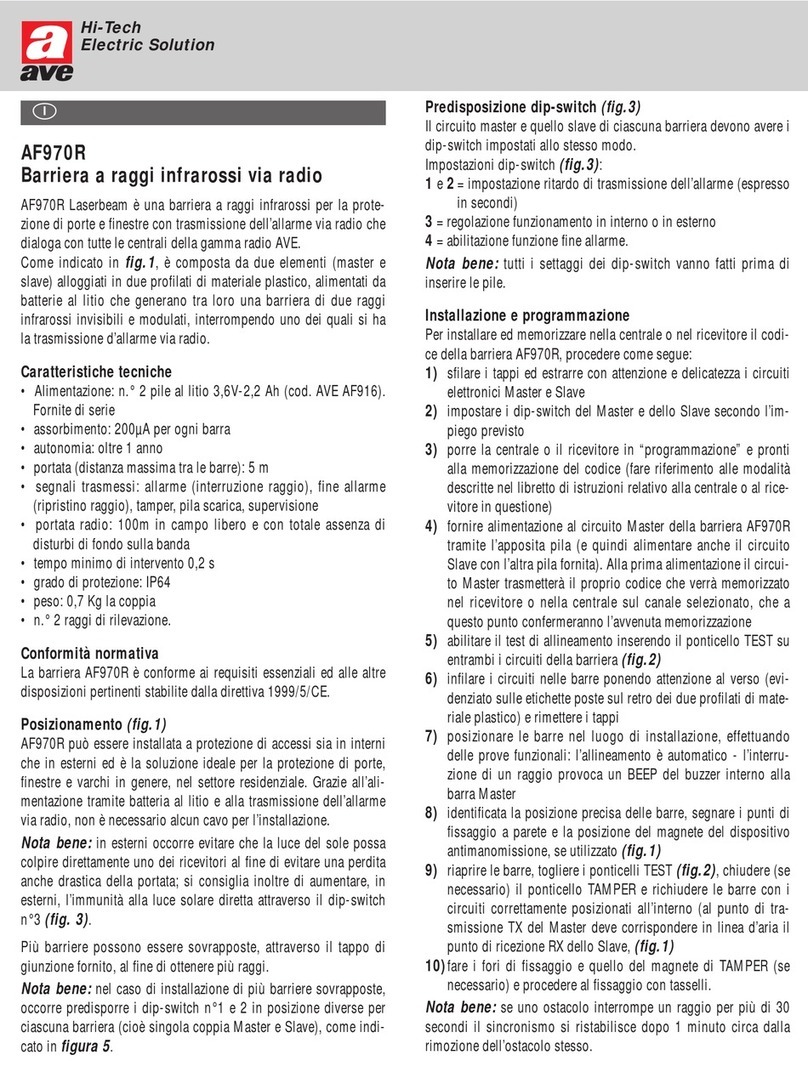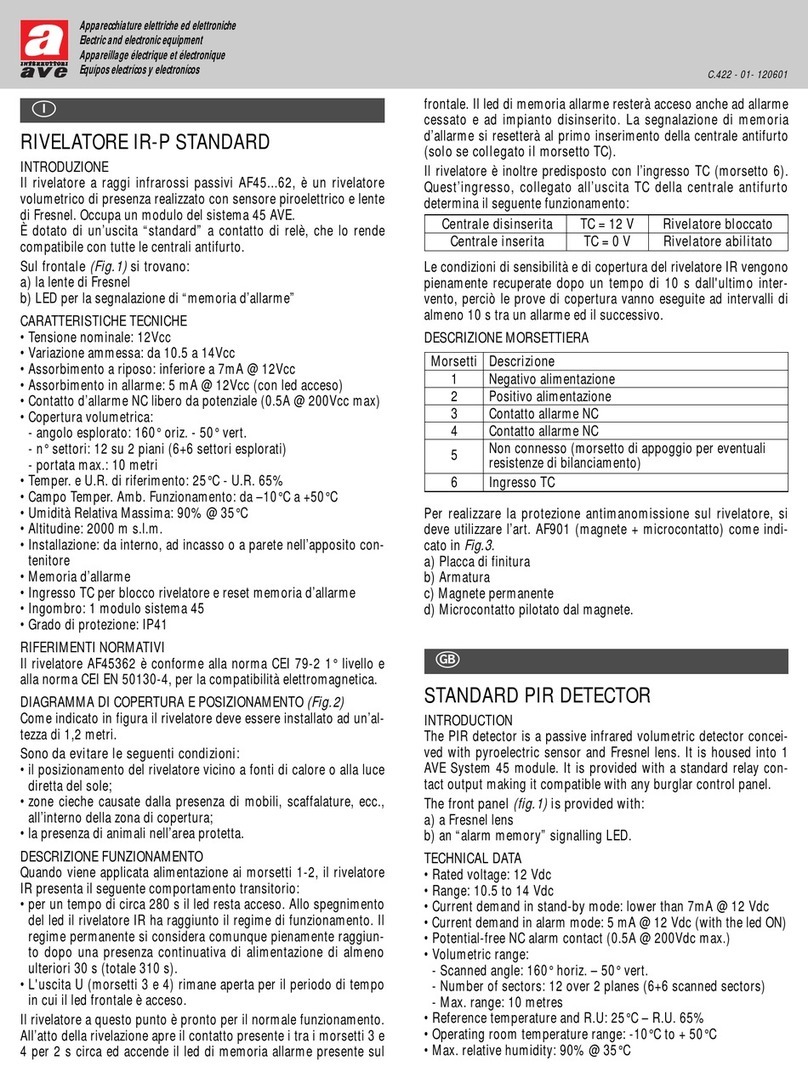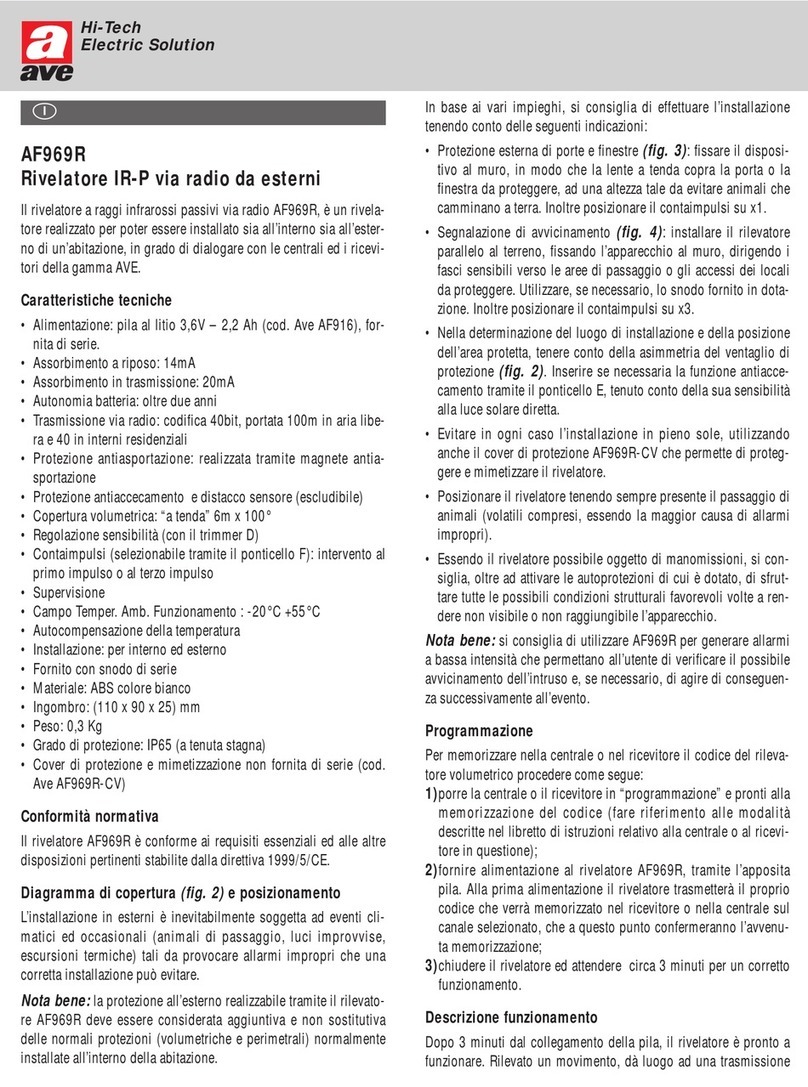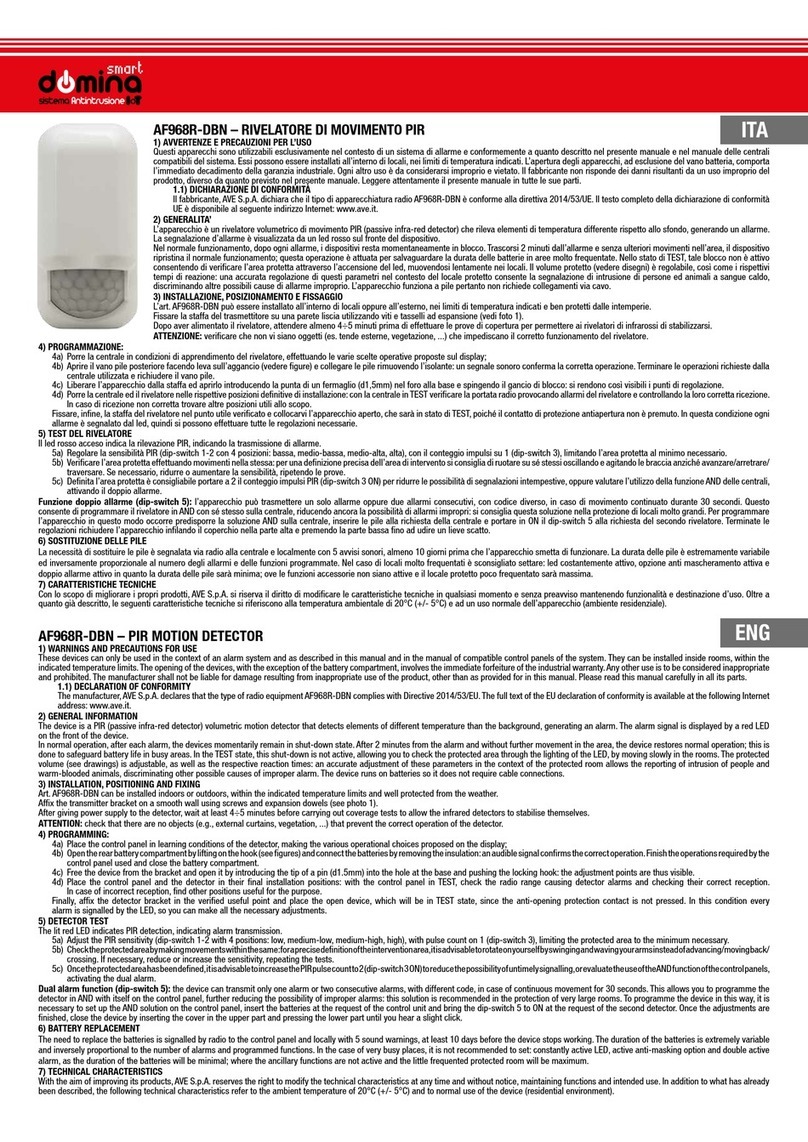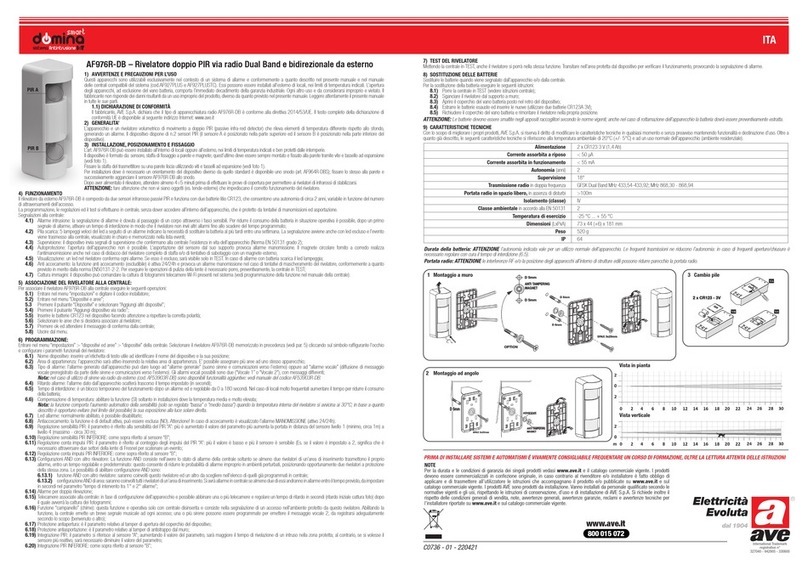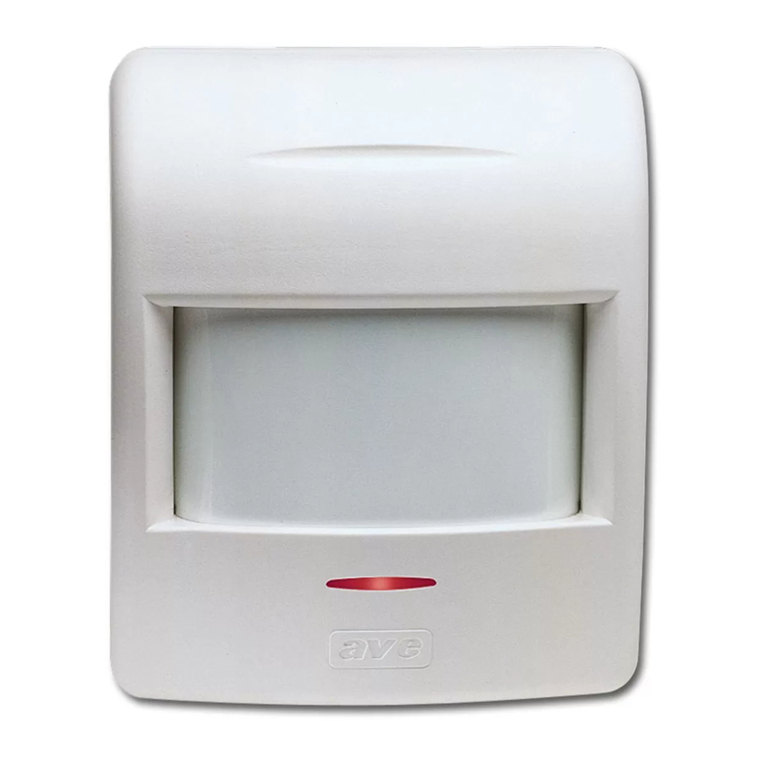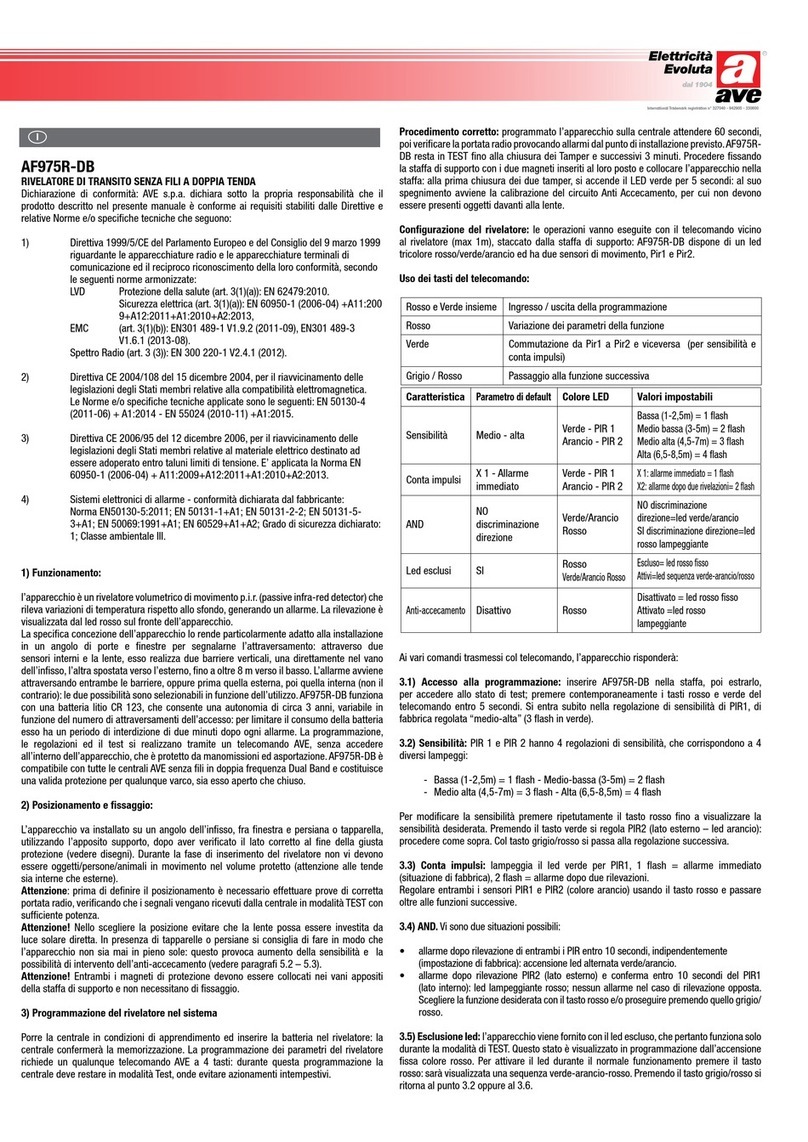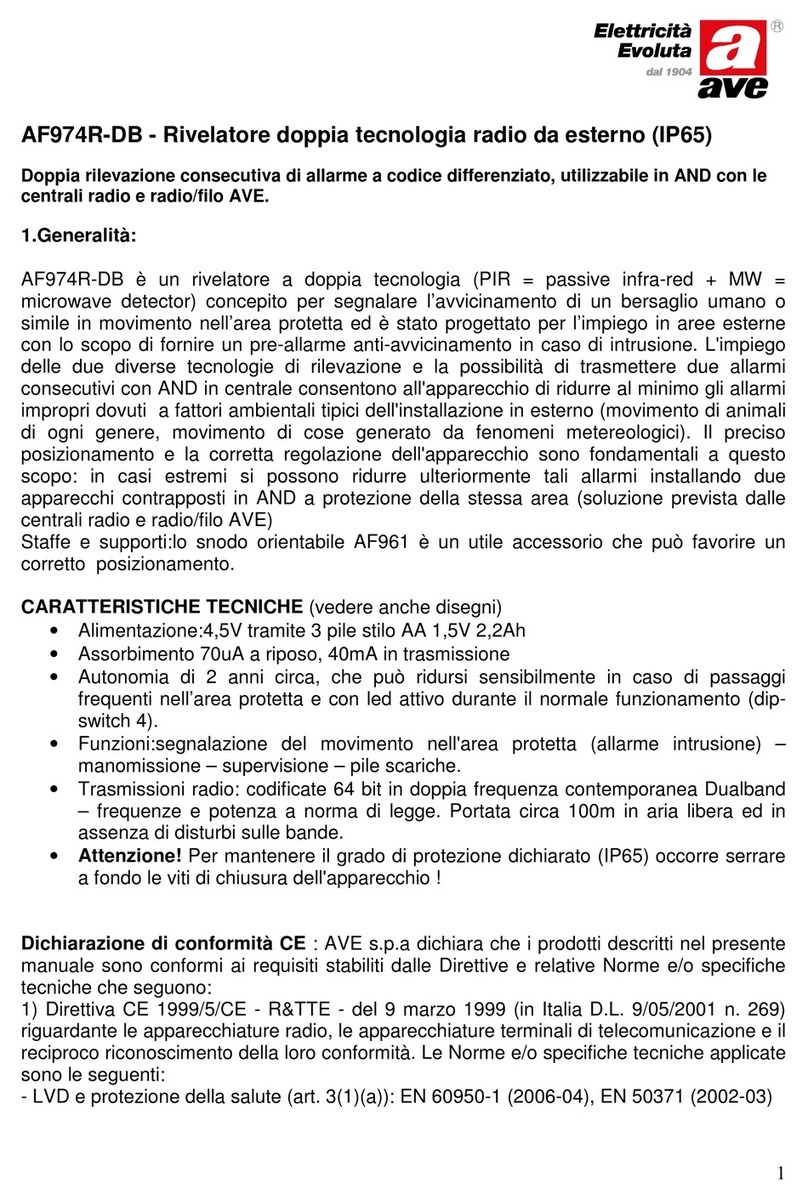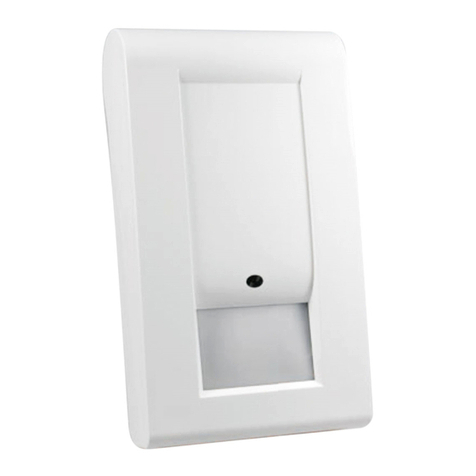
Vista in pianta
Montaggio a muro Cambio pile
Vista verticale
Montaggio ad angolo
1 3
2
NOTE
Per la durata e le condizioni di garanzia dei singoli prodotti vedasi www.ave.it e il catalogo commerciale vigente. I prodotti
devono essere commercializzati in confezione originale, in caso contrario al rivenditore e/o installatore è fatto obbligo di
applicare e di trasmettere all’utilizzatore le istruzioni che accompagnano il prodotto e/o pubblicate su www.ave.it e sul
catalogo commerciale vigente. I prodotti AVE sono prodotti da installazione. Vanno installati da personale qualificato secondo le
normative vigenti e gli usi, rispettando le istruzioni di conservazione, d’uso e di installazione di AVE S.p.A. Si richiede inoltre il
rispetto delle condizioni generali di vendita, note, avvertenze generali, avvertenze garanzie, reclami e avvertenze tecniche per
l’installatore riportate su www.ave.it e sul catalogo commerciale vigente.
PRIMA DI INSTALLARE SISTEMI E AUTOMATISMI È VIVAMENTE CONSIGLIABILE FREQUENTARE UN CORSO DI FORMAZIONE, OLTRE LA LETTURA ATTENTA DELLE ISTRUZIONI
C0725 - 01 - 050620
AF964R-DB – Rivelatore doppio PIR + Microonda via radio Dual Band e bidirezionale
1) AVVERTENZE E PRECAUZIONI PER L’USO
Questi apparecchi sono utilizzabili esclusivamente nel contesto di un sistema di allarme e conformemente a quanto descritto nel presente manuale e nel manuale
delle centrali compatibili del sistema (cod.AF927PLUS e AF927PLUSTC). Essi possono essere installati all’interno di locali, nei limiti di temperatura indicati. L’apertura
degli apparecchi, ad esclusione del vano batteria, comporta l’immediato decadimento della garanzia industriale. Ogni altro uso è da considerarsi improprio e vietato. Il
fabbricante non risponde dei danni risultanti da un uso improprio del prodotto, diverso da quanto previsto nel presente manuale. Leggere attentamente il presente manuale
in tutte le sue parti.
1.1) DICHIARAZIONE DI CONFORMITÀ
Il fabbricante, AVE S.p.A. dichiara che il tipo di apparecchiatura radio AF964R-DB è conforme alla direttiva 2014/53/UE. Il testo completo della dichiarazione
di conformità UE è disponibile al seguente indirizzo Internet: www.ave.it
2) GENERALITA’
L’apparecchio è un rivelatore volumetrico di movimento a triplo sensore: doppio PIR (passive infra-red detector) che rileva elementi di temperatura differente rispetto allo
sfondo, generando un allarme e microonda che analizza le radiazioni riflesse di un corpo in movimento.
3) INSTALLAZIONE, POSIZIONAMENTO E FISSAGGIO
L’art. AF964R-DB può essere installato all’interno di locali oppure all’esterno, nei limiti di temperatura indicati e ben protetti dalle intemperie.
Il dispositivo è formato da: sensore, staffa di fissaggio a parete e magnete; quest’ultimo deve essere sempre montato e fissato alla parete tramite vite e tassello ad espansione
(vedi foto 1).
Fissare la staffa del trasmettitore su una parete liscia utilizzando viti e tasselli ad espansione (vedi foto 1).
Per installazioni dove è necessario un orientamento del dispositivo diverso da quello standard è disponibile uno snodo (art. AF964R-DBS); fissare lo stesso alla parete e
successivamente agganciare il sensore AF964R-DB allo snodo.
Dopo aver alimentato il rivelatore, attendere almeno 4÷5 minuti prima di effettuare le prove di copertura per permettere ai rivelatori di infrarossi di stabilizzarsi.
ATTENZIONE: verificare che non vi siano oggetti (es. tende esterne, vegetazione,...) che impediscano il corretto funzionamento del rivelatore.
4) FUNZIONAMENTO
Il rivelatore da esterno AF964R-DB è composto da due sensori infrarosso passivi dual PIR e da un sensore a microonda. Il rivelatore AF964R-DB funziona con due batterie litio CR123, che consentono un’
autonomia di circa 2 anni, variabile in funzione del numero di attraversamenti del varco in cui è installato.
La programmazione, le regolazioni ed il test si realizzano in centrale, senza dover accedere all’interno dell’apparecchio, che è protetto da tentativi di manomissioni ed asportazione.
Segnalazioni alla centrale:
4.1) Allarme intrusione: la segnalazione di allarme è dovuta al passaggio di un corpo attraverso i fasci sensibili. Per ridurre il consumo della batteria in situazione operativa è possibile, dopo un primo
segnale di allarme, attivare un tempo di interdizione in modo che il rivelatore non invii altri allarmi fino allo scadere del tempo programmato;
4.2) Pila scarica: 5 lampeggi veloci del led a seguito di un allarme indicano la necessità di sostituire la batteria al più tardi entro una settimana. La segnalazione avviene anche con led escluso e l’evento
viene trasmesso alla centrale, visualizzato in chiaro e memorizzato nella lista eventi;
4.3) Supervisione: il dispositivo invia segnali di supervisione che confermano alla centrale l’esistenza in vita dell’apparecchio (Norma EN 50131 grado 2);
4.4) Autoprotezione: l’apertura dell’apparecchio non è possibile. L’asportazione del sensore dal suo supporto provoca allarme manomissione. Il magnete circolare fornito a corredo realizza
l’antimanomissione anche nel caso di distacco del rivelatore completo di staffa e/o di tentativo di sabotaggio con un magnete esterno;
4.5) Visualizzazione: un led nel rivelatore conferma ogni allarme. Se esso viene escluso, sarà visibile solo in TEST. In caso di allarme con batteria scarica il led lampeggia;
4.6) Anti accecamento: la funzione anti accecamento (escludibile) è attiva 24/24h e provoca un allarme manomissione nel caso di tentativi di mascheramento del rivelatore, conformemente a quanto
previsto in merito dalla norma EN50131-2-2. Per eseguire le operazioni di pulizia della lente è necessario porre, preventivamente, la centrale in TEST;
4.7) Cattura immagini: il dispositivo può comandare la cattura di fotogrammi di telecamere Wi-Fi presenti nel sistema (vedi programmazione della funzione nel manuale della centrale).
5) ASSOCIAZIONE DEL RIVELATORE ALLA CENTRALE:
Per associare il rivelatore AF964R-DB alla centrale eseguire le seguenti operazioni:
5.1) Entrare nel menu “impostazioni” e digitare il codice installatore;
5.2) Entrare nel menu “Dispositivi e aree”;
5.3) Premere il pulsante “Dispositivi” e selezionare “Aggiungi altri dispositivi”;
5.4) Premere il pulsante “Aggiungi dispositivo via radio”;
5.5) Inserire la batteria CR123 nel dispositivo facendo attenzione a rispettare la corretta polarità;
5.6) Selezionare le aree da associare al rivelatore;
5.7) Premere ok ed attendere il messaggio di conferma dalla centrale;
5.8) Uscire dal menu.
6) PROGRAMMAZIONE:
Entrare nel menu “impostazioni” > “dispositivi ed aree” > “dispositivi” della centrale. Selezionare il rivelatore AF964R-DB memorizzato in precedenza (vedi par. 5) cliccando sul simbolo raffigurante l’occhio
e configurare i parametri funzionali del rivelatore:
6.1) Nome dispositivo: inserire un’etichetta di testo utile ad identificare il nome del dispositivo e la sua posizione;
6.2) Area di appartenenza: l’apparecchio sarà attivo inserendo la relativa area di appartenenza. E’ possibile assegnare più aree ad uno stesso apparecchio;
6.3) Tipo di allarme:l’allarme generato dall’apparecchio può dare luogo ad un “allarme generale”(suono sirene e comunicazioni verso l’esterno) oppure ad un“allarme vocale” (diffusione di messaggio vocale
preregistrato da parte delle sirene e comunicazioni verso l’esterno). Gli allarmi vocali possibili sono due (“Vocale 1” o “Vocale 2”), con messaggi differenti;
Nota: nel caso di utilizzo di sirene via radio da esterno (cod. AF53903R-DB) sono disponibili funzionalità aggiuntive: vedi manuale del codice AF53903R-DB.
6.4) Ritardo allarme: l’allarme dato dall’apparecchio scatterà trascorso il tempo impostato (in secondi);
6.5) Tempo di interdizione: è un blocco temporaneo del funzionamento dopo un allarme ed e regolabile da 0 a 180 secondi. Nel caso di locali molto frequentati aumentare il tempo per ridurre il consumo
della batteria;
6.6) Compensazione di temperatura: abilitare la funzione (SI) soltanto in installazioni dove la temperatura media è molto elevata;
Nota: la funzione comporta l’aumento automatico della sensibilità (solo se regolata “bassa” o “medio bassa”) quando la temperatura interna del rivelatore si avvicina ai 30°C; in base a quanto
descritto è opportuno evitare (nel limite del possibile) la sua esposizione alla luce solare diretta.
6.7) Led allarme: normalmente abilitato, è possibile disabilitarlo;
6.8) Anti accecamento: la funzione è di default attiva, può essere esclusa (NO). Attenzione! In caso di accecamento è visualizzato l’allarme MANOMISSIONE (attivo 24/24h).
6.9) Regolazione sensibilità PIR: il parametro è riferito alla sensibilità del PIR “A”: più è aumentato il valore del parametro più aumenta la portata in distanza del sensore livello da 1 (minimo, circa 1m) a
livello 4 (massimo - circa 12 m);
6.10) Regolazione sensibilità PIR2: come sopra, riferito al sensore “B”;
6.11) Regolazione conta impulsi PIR: il parametro è riferito al conteggio degli impulsi del PIR “A”: più il numero è basso e più il sensore è sensibile (Es. se il valore è impostato a 2, significa che è necessario
attraversare due settori della lente di Fresnel per scatenare un evento;
6.12) Regolazione conta impulsi PIR2: come sopra, riferito al sensore “B”;
6.13) Configurazioni interattive (AND): La funzione AND consiste nell’avere lo stato di allarme della centrale soltanto se almeno due rivelatori di un’area di inserimento trasmettono il proprio allarme, entro
un tempo regolabile e predeterminato: questo consente di ridurre le probabilità di allarme improprio in ambienti perturbati, posizionando opportunamente due rivelatori a protezione della stessa
zona. Le possibilità di abilitare la configurazione AND sono:
6.13.1) Funzione AND con altro rivelatore: saranno coinvolti questo rivelatore ed un altro da scegliere nell’elenco di quelli già programmati in centrale;
6.13.2) ConfigurazioneAND di area: saranno coinvolti tutti i rivelatori di un’area di inserimento.Si avrà allarme in centrale se almeno due di essi andranno in allarme entro il tempo previsto, da impostare
in secondi nel parametro “tempo di intervento tra 1° e 2° allarme”;
6.14) Telecamere associate alla centrale: in fase di configurazione dell’apparecchio è possibile abbinare una o più telecamere e regolare un tempo di ritardo in secondi (ritardo iniziale cattura foto) dopo
il quale avverrà la cattura dei fotogrammi;
6.15) Funzione “campanello” (chime): questa funzione è operativa solo con centrale disinserita e consiste nella segnalazione di un accesso nell’ambiente protetto da questo rivelatore. Abilitando la funzione,
la centrale emette un breve segnale musicale ad ogni accesso; una o più sirene possono essere programmate per emettere il messaggio vocale 2, da registrarsi adeguatamente secondo lo scopo
(benvenuto o altro);
6.16) Protezione antiapertura: è il parametro relativo al tamper di apertura del coperchio del dispositivo;
6.17) Protezione antiasportazione: è il parametro relativo al tamper di antistrappo dal muro;
6.18) Integrazione PIR: il parametro si riferisce al sensore “A”; aumentando il valore del parametro, sarà maggiore il tempo di rivelazione di un intruso nella zona protetta; al contrario, se si volesse il sensore
più reattivo, sarà necessario diminuire il valore del parametro;
6.19) Integrazione PIR2: come sopra, riferito al sensore “B”;
7) TEST DEL RIVELATORE
Mettendo la centrale in TEST; il rivelatore si porrà automaticamente in funzione TEST. Transitare nell’area protetta dal dispositivo per verificare il funzionamento, provocando la segnalazione di allarme.
8) SOSTITUZIONE DELLE BATTERIE
Sostituire le batterie quando viene segnalato dall’apparecchio e/o dalla centrale.
Per la sostituzione delle batterie eseguire le seguenti istruzioni (vedi foto 3):
8.1) Porre la centrale in TEST (vedere istruzioni centrale);
8.2) Sganciare il rivelatore dal supporto a muro;
8.3) Aprire il coperchio del vano batteria posto nel retro del dispositivo;
8.4) Estrarre le batterie esauste ed inserire le nuove (utilizzare due batterie CR123A 3V);
8.5) Richiudere il coperchio del vano batteria e rimontare il rivelatore nella propria posizione.
ATTENZIONE: Le batterie devono essere smaltite negli appositi raccoglitori secondo le norme vigenti; anche nel caso di rottamazione dell’apparecchio la batteria dovrà essere preventivamente estratta.
9) CARATTERISTICHE TECNICHE
Con lo scopo di migliorare i propri prodotti, AVE S.p.A. si riserva il diritto di modificare le caratteristiche tecniche in qualsiasi momento e senza preavviso mantenendo funzionalità e destinazione d’uso. Oltre a
quanto già descritto, le seguenti caratteristiche tecniche si riferiscono alla temperatura ambientale di 20°C (+/- 5°C) e ad un uso normale dell’apparecchio (ambiente residenziale).
Alimentazione 2 x CR123 3 V (1,4 Ah)
Corrente assorbita a riposo < 50 μA
Corrente assorbita in funzionamento < 55 mA
Autonomia (anni) 2
Supervisione 18°
Trasmissione radio in doppia frequenza GFSK Dual Band MHz 433,54-433,92; MHz 686,30-686,94
Portata radio in spazio libero, in assenza di disturbi >100m
Isolamento (classe) IV
Classe ambientale in accordo alla EN 50131 2
Temperatura di esercizio -25 °C ... + 55 °C
Dimensioni (LxPxA) 73 x 44 (+6) x 181 mm
Peso 520 g
IP 64
ITA
www.ave.it
800 015 072
International Trademark
registration n°
327040 - 942905 - 330600
Portata radio: ATTENZIONE le interferenze RF e/o la posizione degli apparecchi all’interno di strutture edili possono ridurre parecchio la portata radio.
Durata della batteria: ATTENZIONE l’autonomia indicata vale per un utilizzo normale dell’apparecchio. Le frequenti trasmissioni ne riducono l’autonomia: in caso di frequenti aperture/chiusure è
necessario regolare con cura il tempo di interdizione (6.5).

